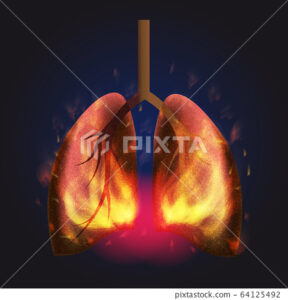
Lung Burning
Bronchiectasis is a chronic respiratory condition characterized by the dilation and damage of the bronchial tubes, leading to recurrent infections and breathing difficulties. Traditional Chinese Medicine (TCM) views bronchiectasis as a pattern of disharmony between different organ systems and identifies several TCM diagnoses associated with this condition. Some of the possible TCM diagnoses for bronchiectasis include:
- Lung and Spleen Qi Deficiency: In TCM, the lungs and spleen are responsible for generating and transporting Qi (vital energy) throughout the body. Bronchiectasis may be caused by a deficiency of Qi in these organs, leading to weakness, fatigue, shortness of breath, and susceptibility to respiratory infections.
- Phlegm-Heat Obstructing the Lungs: This TCM diagnosis refers to an accumulation of phlegm and heat in the lungs, which can cause inflammation and damage to the bronchial tubes. Symptoms may include coughing up thick, yellow sputum, fever, chest pain, and wheezing.
- Kidney and Lung Yin Deficiency: The kidneys and lungs are also closely connected in TCM, and a deficiency of Yin (cooling, nourishing energy) in these organs can lead to bronchiectasis. Symptoms may include dry cough, throat irritation, night sweats, and fatigue.
- Qi and Blood Stagnation: In TCM, stagnant Qi and blood can impair the flow of oxygen and nutrients to the lungs, leading to respiratory disorders like bronchiectasis. Symptoms may include chest pain, coughing up blood, shortness of breath, and fatigue.
Oriental Medicine can help restore the imbalance caused by bronchiectasis through acupuncture, herbs, whole food supplements, light therapy, pulsed electro magnetic frequency, and infrared sauna. This can be done in person or remotely.



